CORREGIDOR ISLAND
The Last Stand of WWII Heroes
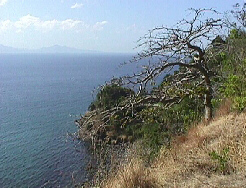
Corregidor Island might have been just a beautiful little tourist resort at the mouth of Manila Bay but for the horrendous battles that scarred every inch of its surface in WWII. This four mile long tadpole shaped island guards the mouth of Manila Bay. Today, it is under the jurisdiction of the Philippine Department of Tourism. Gone are the thousands of soldiers that once inhabited its rocky outcroppings. There is not a trace of the once thriving fishing village of San Jose.

Olive and I took the high speed tourist boat that makes daily runs to Corregidor. It's less than an hour from the dock in Metro Manila. On a clear day, like the one we had, it is a scenic trip across the Bay.
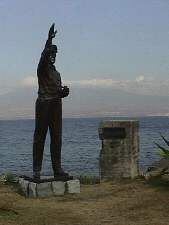
The first bit of history that one encounters on Corregidor is a statue of General Douglas MacCarthur. When it was clear that the American and Philippine armed forces on Corregidor could not withstand the onslaught of the Japanese, McCarthur retreated to Australia in March 1942. He left General Wainwright and some 10,000 troops with the promise, "I shall return." Few of the defenders of Corregidor were alive to witness his return more than two years later.
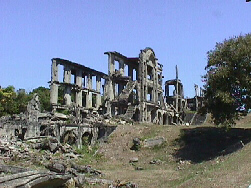
This is the remains of General MacCarthur's house. The island was bombarded first by the invading Japanese and then by the returning Americans. Every building was reduced to ruins. Over 90 percent of the vegetation was destroyed. Not a trace of the flourishing fishing village remains. Huge bomb craters can still be found everywhere. The scattered remains of concrete barracks are all pocked with bullet marks.
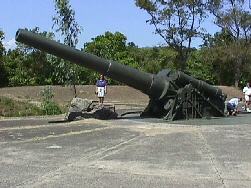
The island was heavily fortified to protect Manila Bay. There were about a dozen large batteries around the island linked by an electric rail system. Huge guns like this one could be pivoted 360 degrees to hit anything in a 20 mile radius.
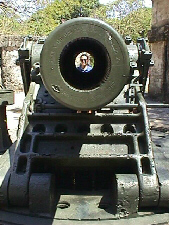
Olive looks down the barrel of one of the smaller cannons that survived. Most of the batteries were completely destroyed by the Japanese bombing of Corregidor just hours after Pearl Harbor. Still, the big guns inflicted heavy damage on the invading Japanese and nearly 2000 died during their assault.
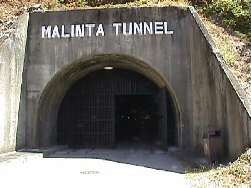
Here is the entrance to Malinta Tunnel which was built in 1932 as a railroad tunnel through the mountain that divides the island into two parts. Under heavy Japanese bombing and artillery barrage, the Americans and Filipinos retreated to this tunnel where they had a hospital and a bomb shelter.
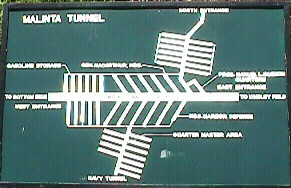
The Americans had developed an extensive tunnel system in the mountain. A series of lateral tunnels were equipped as a hospital, barracks and offices. The hospital was equipped to handle no more than 1000 patients. After resisting the Japanese invaders for five months, the wounded had swollen to over 1500 and all the supplies were exhausted. General Wainwright knew that reinforcements were not coming anytime soon. He had no choice but to surrender to the Japanese. Some 10,000 prisoners were taken across the straits to Bataan where they were marched north in the infamous Bataan Death March. Nearly, all of them perished from hunger and disease.
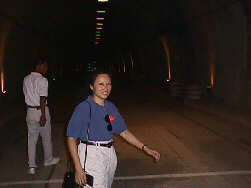
Here is Olive walking through the Malinta Tunnel. Although the lateral tunnels have all collapsed, the main tunnel is still in relatively good repair. When the Americans returned in 1944, our bombing was even more devastating than the Japanese invasion of 1941. Now, it was the Japanese's turn to take cover under the mountain. Without even a glimmer of hope, still the Japanese would not surrender. The Americans poured gasoline down the air vents and then dropped grenades to detonate it. Only 26 of some 2000 remaining Japanese survived the blazing inferno.
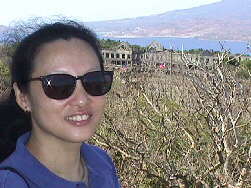
We climbed to the top of an old Spanish lighthouse for a better view of the island. Behind Olive are the ruins of the bombed out barracks. Across the straits is the Bataan Peninsula where the American and Filipino POWs began their death march to the North. Amidst such horrific memories, one cannot help but notice what a beautiful peaceful island Corregidor is today. Life goes on.
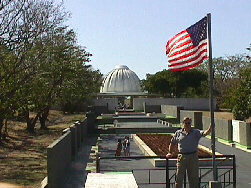
Denny stands by the American flag at the Pacific War Memorial on the "Topside" of Corregidor. The Philippine flag flies on the other side. No Japanese flag. The marble tablets on each side of the walkway recount all the major battles of the Pacific War.

We got back on our tourist trolley and wound back down the quiet country road, past the ruins, back to the sound of gentle waves lapping the rocky shores of Corregidor. Within an hour our boat had sped us back to the urban cacophony of Manila.
CLICK BACK TO THE BARNES FAMILY HOMEPAGE
 Barnes Family Homepage
Barnes Family Homepage












